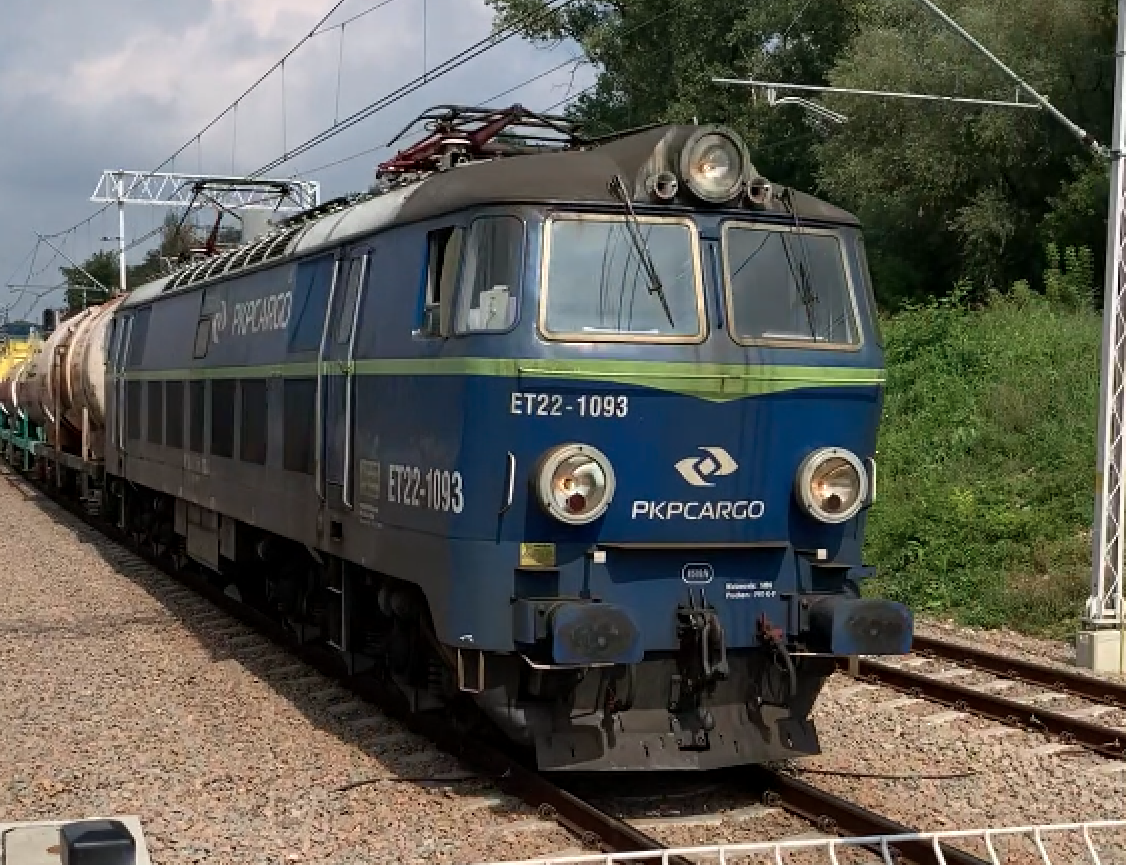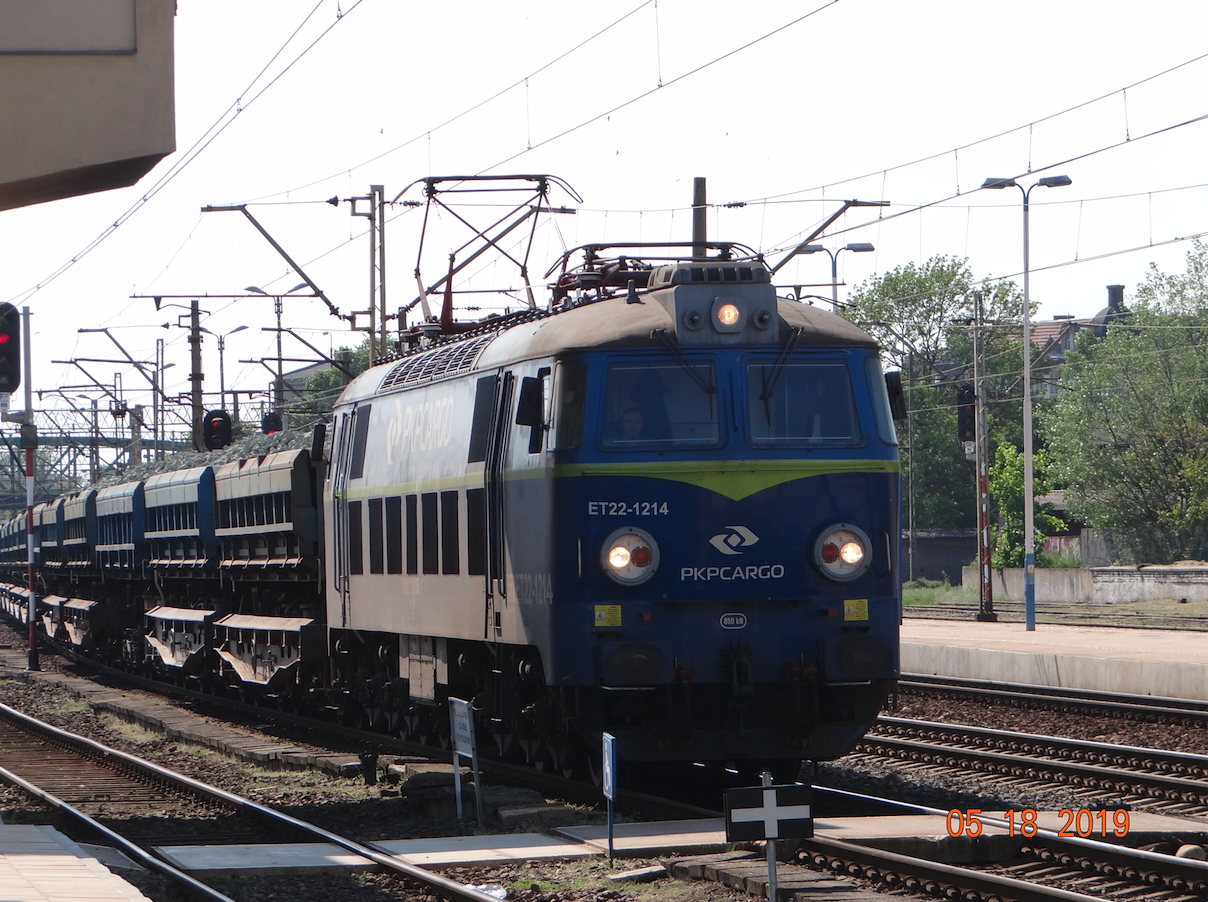Kraków 2021-09-27
Electric locomotive ET22.


The ET22 is a Polish heavy locomotive produced in the period 1969 - 1989 in the PaFaWag factory under the designation 201E. A total of 1,184 units for PKP and 23 locomotives for Morocco were produced.
The ET22 locomotive was developed at the railway construction office in Poznań. The project was based on the experience of operating ET-21 locomotives, which had been in use since 1957. The locomotive was initially designated 7E, and was eventually designated 201E. Due to the long production period, the locomotive underwent several modifications.
Until 2001, ET22 locomotives were used by PKP, and in 2001, as a result of changes, all of them were transferred to PKP Cargo. In the following years, many locomotives went to other carriers operating in Poland. Since 2005, some ET22s can travel on the Czech and Slovak railways.
Construction development.
In Poland, the electrification of railroads began in earnest in 1957. Until 1960, about 100 km of routes were electrified annually. In the 60 years, the electrification rate increased to 200-250 km per year, to slow down in 1988 to virtually zero. And not because of complete electrification, but because of the incompetence of the communist authorities.
The increase in the length of electrified routes required the supply of more powerful electric locomotives. There was already a good ET21 locomotive in mass production, but an even more powerful one was needed.
In 1964, the Central Design Office of the Rolling Stock Industry, now the Institute of Rail Vehicles in Poznań, began developing a new heavy electric locomotive. In order to speed up the work and use the already existing solutions and components, the 4E (EU07) design was used. The constructors saw the future locomotive as universal, not just a freight one. The final decision was made by the party authorities in Warsaw - it is to be ET22. In 1966, the design was designated 7E. During the works, the designation was changed to 201E. The PaFaWag plant in Wrocław was designated as the manufacturer. The first two prototypes were built there: ET22-001 and 002. The prototypes were delivered to the Kraków Prokocim depot for testing.
In 1971, the first 10 serial ET22 locomotives (003-012) were built. At the same time, the production of the ET21 locomotives was discontinued. About 90 locomotives were built annually. In the period 1975–1976, PaFaWag produced 23 locomotives type 201Eg (ET22) for Morocco. A total of 1 207 electric locomotives were built.
In the period 1971-1973, experiments were carried out to change the gear ratios of electric motors. They wanted to obtain a freight electric locomotive with a design speed of 125 km / h and a fast electric locomotive with a speed of 160 km / h. In 1978, a modernized locomotive body suspension was developed.
Despite the possibility of driving in multiple traction, in the end the ET22 locomotives did not cooperate with each other. Their high power caused the electrical devices in the second locomotive to burn and the screw couplers to break off. It was practically the end of the possibility of compiling trainsets from the then wagons. Due to the high tractive power, the electric locomotive is commonly called "Taurus".
By 1997, the 33 ET22 locomotives had been removed from the state. By 2000, another 192 electric locomotives were removed from the state. This does not mean, however, that all the locomotives were scrapped. Many of them are waiting for better times. When the PKP Cargo company was established in 2001, it took over 955 ET22 locomotives, that is all, including EU07. As PKP IntrCity did not have any locomotives, it had to sublet the locomotives from PKP Cargo. As a result, the trains often pulled ET22 electric locomotives, which was not inappropriate due to the characteristics of the ET22.
At the beginning of the 21st century, there was a need to modernize the existing electric locomotives. In 2004, one locomotive was modernized in Gliwice, which, after tests, became a prototype for the modernization of subsequent electric locomotives. From 2007, more locomotives were rebuilt. Several dozen ET22 locomotives were modernized.
From 2010, ET22 locomotives were transferred to other carriers in the country.
In 2007, the first ET22 locomotive hit the routes in the Czech Republic. In 2008, the first locomotive hit the routes in Slovakia. In 2016, PKP Cargo had 24 ET22 series locomotives approved for use in the Czech Republic.
Construction ET22.
The box and the stand are a whole and a self-supporting structure made as welded. The sides of the box in the upper part are inclined towards the center to maintain the dimensions of the gauge, similar to the SU45 locomotive. The roof in the middle is removable for easy handling. There are two pantographs on the roof. The locomotive starts and ends in driver's cabins. The machinery space consists of three parts. The high voltage compartment was placed in the central part of the electric locomotive. The locomotive has two three-axle bogies. Each trolley has three EE541 motors. Total continuous power is 3 MW. The gear ratio of the engines is 79:18.
T-T ET22 Data:
Co'Co 'axis system. Length 19.24 m. Width 3.00 m. Height 4.46 m. Service weight 120,000 kg. Axle load 20,000 kg. Wheel diameter 1.25 m. Electricity supply 3,000 V. Motor type EE541. The gear of the motors 79:18. Design speed 120 km / h. Oerlikon brake system.
Written by Karol Placha Hetman
